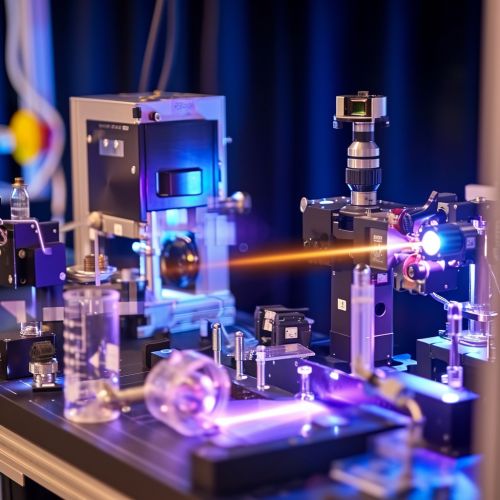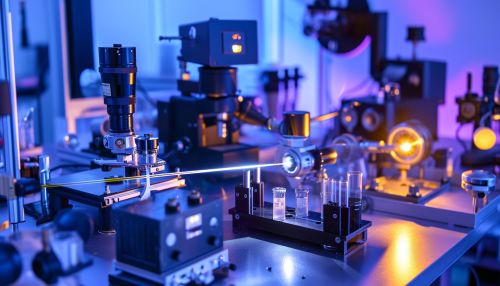Laser spectroscopy
Introduction
Laser spectroscopy is a scientific technique that uses the interaction of light with matter to study the properties of atoms, molecules, and materials. It is a key tool in many areas of physics, chemistry, and engineering, providing detailed information about the structure and behavior of a wide range of substances.


Principles of Laser Spectroscopy
Laser spectroscopy is based on the principles of quantum mechanics, which describe the behavior of particles at the atomic and subatomic level. According to these principles, atoms and molecules can exist in a number of different energy states, and can transition between these states by absorbing or emitting light. The energy of the light corresponds to the difference in energy between the initial and final states, and is determined by the frequency or wavelength of the light.
In laser spectroscopy, a laser is used to produce light of a specific frequency, which is then directed at the sample to be studied. The sample absorbs the light and transitions to a higher energy state, and then emits light as it returns to a lower energy state. By measuring the frequency of the emitted light, and comparing it to the frequency of the incident light, the energy difference between the states can be determined. This information can be used to identify the substance being studied, to determine its structure, and to investigate its behavior under different conditions.
Types of Laser Spectroscopy
There are many different types of laser spectroscopy, which use different methods to probe the properties of the sample. These include absorption spectroscopy, emission spectroscopy, and scattering spectroscopy, among others.
Absorption Spectroscopy
In absorption spectroscopy, the laser is tuned to a frequency that corresponds to a transition between two energy states of the sample. The intensity of the laser light is measured before and after it passes through the sample, and the difference in intensity is used to determine the amount of light absorbed by the sample. This can provide information about the concentration of the substance in the sample, as well as its absorption cross-section, which is a measure of its ability to absorb light of a particular frequency.
Emission Spectroscopy
Emission spectroscopy is the opposite of absorption spectroscopy. In this technique, the sample is excited to a higher energy state, either by a laser or by other means, and then allowed to relax back to a lower energy state. The light emitted by the sample as it relaxes is collected and analyzed, providing information about the energy levels of the sample and the transitions between them.
Scattering Spectroscopy
Scattering spectroscopy involves the interaction of the laser light with the sample, resulting in the light being scattered in different directions. The scattered light can be analyzed to provide information about the size, shape, and structure of the sample, as well as its refractive index and other optical properties.
Applications of Laser Spectroscopy
Laser spectroscopy has a wide range of applications in many different fields. These include:
Physics
In physics, laser spectroscopy is used to study the properties of atoms and molecules, including their energy levels, transition probabilities, and lifetimes. It is also used to investigate the properties of materials, such as their optical, electronic, and magnetic properties.
Chemistry
In chemistry, laser spectroscopy is used to study the structure and dynamics of molecules, including their vibrational and rotational modes, and their reactions with other molecules. It is also used to measure the concentrations of substances in samples, and to detect trace amounts of substances in complex mixtures.
Engineering
In engineering, laser spectroscopy is used to characterize materials, to measure their properties, and to monitor processes. It is also used in non-destructive testing, where it can provide information about the internal structure and composition of a material without damaging it.
Future Directions
The field of laser spectroscopy is continually evolving, with new techniques and applications being developed all the time. Future directions for research in this field include the development of new types of lasers, the application of laser spectroscopy to new types of materials and systems, and the integration of laser spectroscopy with other techniques to provide more detailed and comprehensive information.
